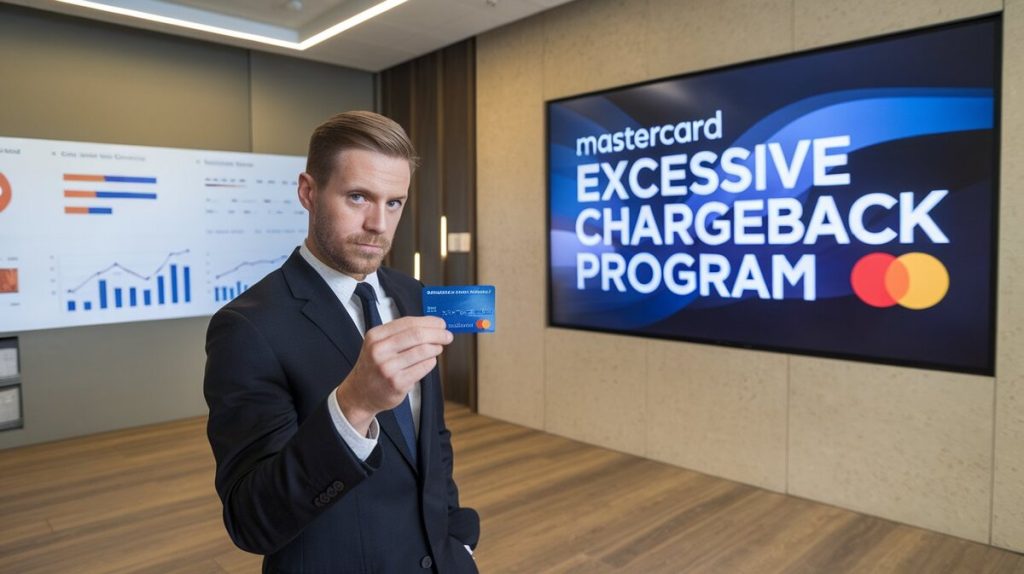Managing chargebacks is crucial for online businesses. Chargebacks can lead to significant financial losses and affect a merchant’s standing within the payment network. To maintain the integrity of its payment system, Mastercard enforces the Excessive Chargeback Program (ECP). This program monitors merchants who exceed specific chargeback thresholds, imposing penalties and requiring corrective actions to ensure compliance.
This article provides a detailed examination of the Mastercard ECP, outlining how it works, the thresholds involved, and the penalties for non-compliance. Additionally, it offers practical advice on how merchants can avoid excessive chargebacks.
Overview of the Mastercard Excessive Chargeback Program
The Mastercard Excessive Chargeback Program (ECP) is designed to monitor merchants who consistently exceed acceptable chargeback thresholds. The program aims to protect the payment network by identifying high-risk merchants and enforcing corrective measures.
Key Elements of the ECP
- Chargeback Monitoring:
- Mastercard tracks the chargeback activity of all merchants.
- The evaluation is based on two key metrics: the number of chargebacks and the chargeback-to-transaction ratio.
- Thresholds for Monitoring:
- Chargeback Monitored Merchant (CMM): 100+ chargebacks in a month with a chargeback-to-transaction ratio of 1% or higher.
- Excessive Chargeback Merchant (ECM): 100+ chargebacks each month with a chargeback ratio of 1.5% or higher for two consecutive months.
- High Excessive Chargeback Merchant (HECM): 300+ chargebacks with a chargeback-to-transaction ratio of 3% or more.
Table 1: Chargeback Monitoring Thresholds
| Category | Chargebacks Per Month | Chargeback Ratio |
|---|---|---|
| Chargeback Monitored Merchant | 100+ | 1.0%+ |
| Excessive Chargeback Merchant | 100+ | 1.5%+ |
| High Excessive Chargeback Merchant | 300+ | 3.0%+ |
- Program Consequences:
- Merchants exceeding these thresholds are placed in the ECP and may face fines, penalties, or termination of their merchant accounts if they do not correct the issue.

Purpose and Enforcement of the ECP
The main goal of the ECP is to reduce chargebacks, maintaining the integrity of the Mastercard network. By penalizing merchants with high chargeback rates, Mastercard encourages better business practices.
Penalties: The fine structure begins at $1,000 and can reach up to $100,000 per month for continued non-compliance. This escalation stresses the importance of addressing chargeback issues quickly.
How the Mastercard Excessive Chargeback Program Operates
Monitoring Process
Mastercard’s ECP uses continuous monitoring of merchant activity. Data on both card-present and card-not-present transactions is collected. When a merchant breaches the set thresholds, Mastercard notifies the acquirer, who then informs the merchant.
The ECP includes two levels of monitoring:
- Chargeback Monitored Merchant (CMM): Serves as an initial warning.
- Excessive Chargeback Merchant (ECM): Active penalty phase with fines and compliance requirements.
Table 2: Penalty Structure for ECM and HECM
| Time in Program | ECM Fine | HECM Fine | Additional Penalties |
|---|---|---|---|
| 1 Month | $0 | $0 | None |
| 2 Months | $1,000 | $1,000 | None |
| 3 Months | $1,000 | $2,000 | Issuer Recovery Assessment: $5/chargeback after the first 300 |
| 4-6 Months | $5,000 | $10,000 | Issuer Recovery Assessment |
| 7-11 Months | $25,000 | $50,000 | Issuer Recovery Assessment |
| 12-18 Months | $50,000 | $100,000 | Issuer Recovery Assessment |
| 19+ Months | $100,000 | $200,000 | Issuer Recovery Assessment |
Remediation and Compliance
Merchants classified as ECM must create a remediation plan to reduce chargebacks. This plan often includes:
- Anti-fraud tools to prevent chargebacks.
- Enhanced customer service to resolve disputes before they become chargebacks.
- Improved transaction processes to minimize errors leading to chargebacks.
Merchants remain in the program until they achieve three consecutive months with chargeback rates below the thresholds.

Penalties for Non-Compliance
The consequences of non-compliance in the ECP are significant. Fines escalate based on the duration of non-compliance, starting at $1,000 and reaching up to $100,000 per month for ECMs and $200,000 per month for HECMs after 18 months. Continued non-compliance can also result in the Issuer Recovery Assessment and ultimately, account termination.
If a merchant is non-compliant for more than 12 months, Mastercard may recommend account termination. This often leads to the merchant being placed on the MATCH list (Member Alert to Control High-Risk Merchants), making it difficult to secure another merchant account.
Best Practices to Avoid the ECP
To avoid the severe penalties associated with the ECP, merchants should take proactive steps to manage their chargeback rates. Here are some effective strategies:
- Implement Effective Fraud Prevention Tools:
- Use real-time fraud detection systems to identify and block suspicious transactions.
- Merchanto.org, an official partner of Visa and Mastercard, offers comprehensive solutions for chargeback prevention. Their tools integrate with your payment processing systems, providing robust protection against chargebacks. Learn more.
- Improve Customer Communication:
- Ensure transaction descriptors are clear and recognizable.
- Provide multiple customer service channels to resolve disputes before they become chargebacks.
- Maintain Comprehensive Records:
- Keep detailed records of all transactions, customer communication, and shipping details. This documentation is vital for disputing chargebacks.
- Review and Update Policies:
- Ensure refund and return policies are clear and accessible to customers. Regularly update these policies to align with best practices.
Table 3: Chargeback Prevention Best Practices
| Strategy | Details | Impact |
|---|---|---|
| Fraud Detection Tools | Implement real-time fraud detection systems. | Reduces fraudulent transactions, lowers chargebacks. |
| Clear Communication | Use clear transaction descriptors and provide excellent customer service. | Prevents misunderstandings that lead to chargebacks. |
| Detailed Record Keeping | Maintain detailed transaction records. | Improves chances of winning chargeback disputes. |
| Policy Transparency | Ensure refund and return policies are clear and accessible. | Reduces disputes and customer dissatisfaction. |
Conclusion
The Mastercard Excessive Chargeback Program is essential for maintaining the security and integrity of the payment network. By understanding the program and implementing best practices, merchants can avoid the severe penalties associated with excessive chargebacks.



